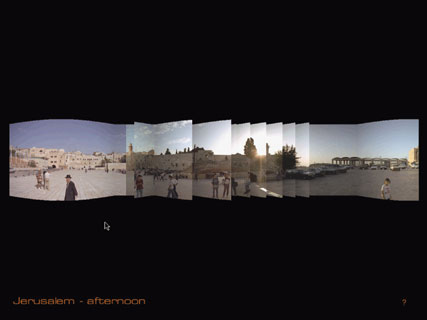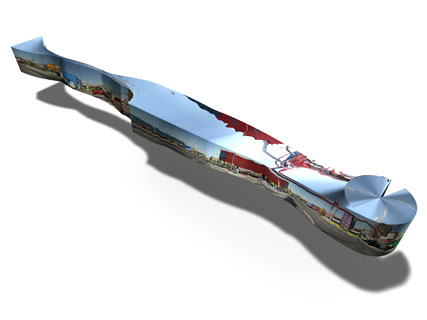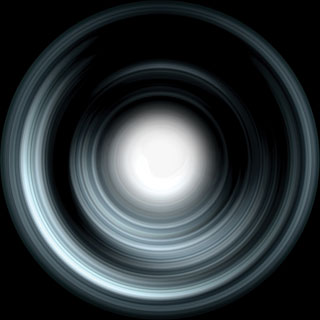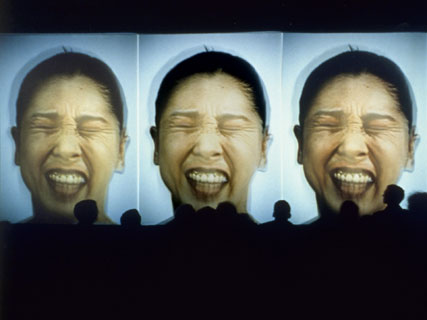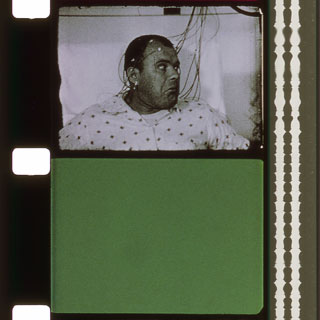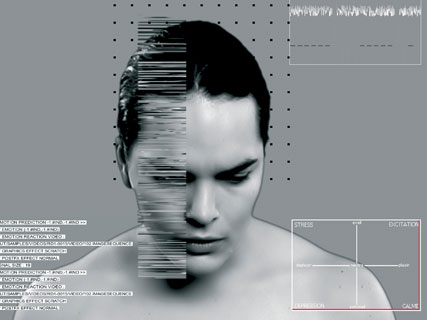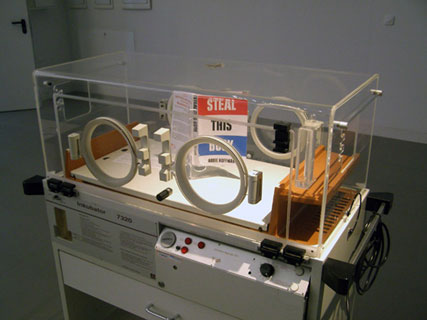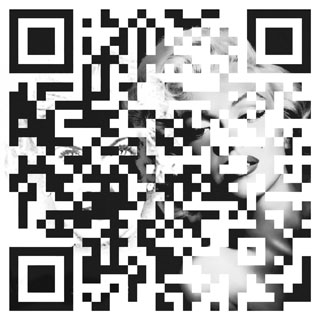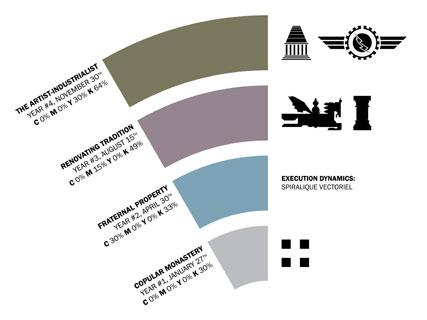Three exhibitions, “From Sparks to Pixels” at Martin Gropius Bau and “Conspire”, organised by the Transmediale Festival, both of them in Berlin and “Exploding Cinema” at the Rotterdam International Film Festival, recently broached the use of technology and digital media in the field of art, with very different approaches.
 T
The subtitle of the exhibition “From Sparks to Pixels” is relatively clear: “Art + New Media”. Yet it is with one of the lowest of the “Low Tech” pieces dating from the middle of the 1970’s that Richard Castelli opened his exhibition. The installation is called “Candle TV” and evokes the critical fascination media held for artists at the end of the last century. Its author, Nam June Paik, took out all the inner electrical workings of a television and replaced them with a simple candle whose flame still rivals the incessant flow of broadcasted images.
Romy Achituv
& Michael Naimark,
“BeNowHere Interactive”,
1997.
 Representing time
Representing time
 B
But there are also a few installations in this exhibition following the example of “BeNowHere Interactive” conceived by the Israeli artist
Romy Achituv in 1997, that makes it possible to explore the relationship between the image and time with the support of a lot of technology and media. This particular installation presents a dozen panoramic views of Angkor, Dubrovnik, Jerusalem and Timbuktu. The photographic panoramas follow one upon the other depending on the lateral displacement of a video window that, like a temporal wave, refreshes the image. The spectator, taking hold of a mouse, can then direct the wave and reveal the time and the life the image harbours. Depending on the clicks on the left or right of this undulating movement, they are able to move forwards or backwards as though it were a simple videotape. In this way they can simultaneously explore multiple spaces in multiple times. As soon as the device is “abandoned” the wave resumes its autonomy. Inexorably, it awakes those who are dozing in the images, in order to freeze them again.
Dirk Lüsebrink
& Joachim Sauter [Art+Com],
“The Invisible Shapes of Things Past”, 1996-2007.
 T
The Germans Dirk Lüsebrink and
Joachim Sauter also question the relationship between the image and time in a series of works initiated in the middle of the 1990’s: “The Invisible Shapes of Things Past”. Their basic material is again filmic, but the artists reorganise the images that have been acquired earlier within three-dimensional spaces. Entire series of photographs are re-positioned on the camera trajectories that have captured them. So a forward dolly shot becomes a cube while a panorama is converted into a cylinder and a zoom into a flattened pyramid. The envelopes of these same temporal objects, striated by the time that has passed, are like geological core samples where each layer of their make-up bears witness to a unit of time. It is through combinatronics that diverse camera movements follow one another allowing the artists to obtain sculptures that are more complex; instants where the camera movements seem to be petrified in space, frozen in time through a few sudden eruptions.
Ulf Langheinrich,
“Hemisphere”,
2006-2007.
 Audiovisual performances
Audiovisual performances
 T
The performance installation “Hemisphere” by the Austrian artist Ulf Langheinrich is among the most recent pieces of this exhibition, relatively speaking, because it dates from 2006-2007. The public is invited to sit comfortably above a demi-sphere whose interior surface provides the screen for the images being projected. The experience is truly immersive since one’s visual field is entirely inhabited by the image, during which, sounds emit from the perimeter of the hemisphere. At the beginning, the image is only made of moving noises that are amplified by a buzzing. Then blotches take shape and come apart on the surface of asphalt heated by the summer sun. Later on, concentric lines appear to marry the inside of this demi-sphere which then takes on the allure of a clay bowl turning at high speed. The experience is communal, so some people exchange their sensations while others let themselves be carried along by the voyage being proposed. It is when the images combine with sound and manage to take us out of our sluggishness that we seem to be falling through space for the period of an endless fall. Toward the end of the performance, it even becomes impossible to extricate oneself, the coloured and stroboscopic lights being so powerful. Any resistance is practically useless when the images cross our eyelids and the sounds resonate in our flesh.
 W
We leave Berlin for the Rotterdam
International Film Festival that brings together several exhibitions, all localised around Witte de Withstraat, under the heading “Exploding Cinema” that consequently questions “other” forms of cinema. It’s within the space of the
V2_ Institute, specialising in unstable media that we find Ulf Langheinrich with a performance dating from the period when he was collaborating with Kurt Hentschläger. It was at the V2_ Institute moreover that the two members of the Granular Synthesis collective gave their first ever performance of “Model 5” in 1996.
Granular Synthesis,
“Model 5”, 1996.
 T
The projected video image, which is a dozen metres wide, is cut into four parts that are filled with the face of the performance artist Akemi Takeya. The shots are close-up and expressions multiple. Ulf Langheinrich and Kurt Hentschläger have isolated a multitude of sequences after filming the young Japanese, to extract audio-video loops of a few fractions of a second that they then reassembled. The repetition of the faces in the space of the image is reinforced by those of the sequences in the time of which the sounds are echoed. The facial expressions express a panoply of sentiments ranging from serenity, when the eyes are closed, to suffering, when the mouth is tense. But it is between the images where everything happens, retinal persistence allowing us to reconstitute the visuals that are only imprinted in our thoughts. From these faces in fibrillation, we only retain those that correspond to our unconscious state at the time. As for the silence of the after-performance in the audience, it only lasts for the time it takes for these same phantom-like images to dissipate.
Paul Sharits,
“Epileptic Seizure Comparison”,
1976.
 Suffering and torture
Suffering and torture
 Y
You only have to cross the street to go from the V2_ Institute to the Witte de With Contemporary Art Centre where three radical artists are being exhibited, one of them being the American
Paul Sharits. This latter is known for his flashing films, but it’s in observing works comparable to paintings that we understand his work methods, directly inspired by musical composition. The “Frozen Film Frames” are made up of 16mm films whose images have been coloured one after the other. The vision of these “colour charts” helps to apprehend films like “Declarative Mode” where a rectangle, whose colours can change up to 24 times a second, is projected inside another that is also flashing. The two reels are in fact the same in every way, except one has been turned on a second before the other. One can see a kind of temporal prolongation of the work that is no less obsessional about colour than a Joseph Albers, but anyone suffering from epilepsy is warned against the projection, a sickness that according to Yann Beauvais, “Paul Sharits has always dreaded”.
 E
Epilepsy is in fact the subject of the installation “Epileptic Seizure Comparison” of 1976. This installation functions around a corner closed off by 16mm film images. In the upper projection, like the lower projection, there are men suffering with electrodes attached to their skulls, placing us in a medical context. Bright colours regularly perturb the two projections. The films come from medical studies conducted on the cerebral activity of patients during epileptic seizures. So our condition is as spectator looking upon their sufferings, incapable of stopping the experience or the patient’s cries. Everything here puts us in an uncomfortable position. And then there are the incessant flashes that seem to directly attack our brains before the filters of thought are ready to react. This installation is in fact nothing more than a trap from which it is difficult to remove oneself.
Vincent Elka,
“Sho(u)t”,
2005/2007.
 L
Let's go through the Witte de Withstraat again to visit MAMA whose initials stand for: Media And Moving Art. An exhibition is structured there around the interactive installation “
Sho(u)t” by the French artist Vincent Elka. I know this piece for having “missed out on it” a few months ago. So this time I’m resigned to enter into contact with the avatar of this video projected woman at the back of the room. But first of all I have to get up the courage to mount the little platform that is placed before her imposing face. As for her, she is waiting in a sonorous ambiance that reminds one of an observation ward. I speak to her through the microphone that has been placed there for that purpose, but she hardly reacts. So I start shouting. The work is called “Sho(u)t” after all! And it is then that the machine reacts placing spinning graphic elements around her head. The image sometimes gets scrambled like a monitor that has lost its signal, but the communication is far from broken. The more I shout, the more animate she becomes, and then she gets annoyed. The rhythm of the sounds accelerates while volume increases. Everything here encourages me to scream louder until I recall a passage from the film “I Comme Icare” by Henri Verneuil where a man tortures another under the pretext of research. The scientific universe here has given way to the inevitable “Black Box”, but I’ve been no less the dupe!
 I
It is high time to leave Rotterdam to go back to Berlin where the 21st
Transmediale is being held. The festival has taken up residence again at the “House of World Cultures” after two years at the Fine Arts Academy. The conferences, performances and other exhibitions, including one called ”Conspire” organised by the curator Nataša Petrešin-Bachelez, express themselves around the notions of conspiracy. So one can expect works that are situated somewhere between art and politics. Stephen Kovats, the artistic director of Transmediale who comes from the V2_ Institute in Rotterdam, takes a different notion from Marcel Duchamp to evoke conspiracy: “inframince”, defined by its author as a “fragile and ultimate threshold that separates reality from its complete disappearance”.
Ubermorgen, Paolo Cirio
& Alessandro Ludovico,
“Amazon Noir - The big book crime”, 2006.
 The art of hacking
The art of hacking
 S
Several of the installations in the exhibition “Conspire” like “
Amazon Noir - The big book crime” that come from an association between the Austrian collective
Ubermorgen and the artists Paolo Cirio and Alessandro Ludovico, participate in hacking. These latter have in fact hacked the application “Search inside the book“ that the virtual library Amazon.com makes available to its clients who want to read a few paragraphs of a book before buying it online. The service functions by sending key words, so the artists developed a robot capable of sending thousands to “suck out” the contents of entire books before putting them into circulation on a Peer to Peer server. They explain their “misdeed” in projected images that frame the incubator containing the “print copy” of a book with a predestined title, “Steal this Book”, written at the beginning of the 1970’s by Abbie Hoffman, one of the founders of the “Youth International Party”. There is no need to point out that the lawyers of the online bookstore were in rapid contact with the artists who agreed to sell their application to Amazon for an undisclosed sum. Through this action, of which only the installation and a web site remain, the artists once again question the notion of “Copyright” like the notion, dear to the Ubermorgen Collective of “original” in the digital era.
Olga Kisseleva,
“Cross Worlds”,
2007.
 A
At the entry to the exhibition there is a piece on the floor by
Olga Kisseleva entitled “Cross Worlds” that is similar to the one she temporarily placed in the Abbey of Maubuisson. Both of them involve graffiti or semacodes - pictograms that deliver their messages to those who photograph them with the help of their cellphones equipped with the appropriate decoding programs. It is a guaranteed technology for the future that artists, following Olga Kisseleva’s lead, are already grabbing on to. It is a technology that makes it possible to conceal a few messages, here or there in this “inframince”, at the frontiers of the visible. The artist moreover is also revealing an interest in the invisible when she asked a laboratory to measure hyperfrequencies at the Abbey of Maubuisson in order to draw up maps of invisible electromagnetic forces that surround us more and more each day.
Société Réaliste,
“Transitioners : Le Producteur”,
2008.
 New offices
New offices
 I
In the exhibition we hear someone that seems to be telling a story from afar. This someone is called Jean-Baptiste Naudy and he is accompanied by Ferenc Gróf. The Parisian “artistic cooperative”
Société Réaliste is thus complete at the centre of its circular installation entitled “Transitioners: Le Producteur” presented by them like an “office for political trends”. Faithful to the Italian tradition of the Cantastoria, Jean-Baptiste Naudy speaks and gesticulates at the same time, shows images, sometimes words and moves around and speaks directly to people in the audience. The interior of the circular panorama that surrounds us, which is comparable to the gigantic “colour charts” of Gerhart Richter, is made up of as many colour rectangles as there are days in the year. There are zones that contain pictograms, where heraldry turns into the science of the logotype, while others contain words or texts that bear witness to historical Utopias. The two other artists propose as many “democratic transitions” through their 2008 collection as combinatorics make possible.
Bureau d'Etudes,
“End of Secrecy”,
2008.
 “A
“Apocalyptic scenarios prophesizing the end of our over-populated world justify the demiurgical experimentations of the world become laboratory”, say Léonore Bonaccini and Xavier Fourt, members of the French collective
Bureau d'Etudes. Their project, presented in the form of a video installation at Transmediale, is called “End of Secrecy”, but it is accessible online at “
laboratoryplanet.org”. It consists of mapping the planet by revealing a multitude of entities whose research activities into the most diverse technologies has been kept secret. The maps, which are regularly refreshed, are then full of pictograms showing where they are. It is that which is the end of secrecy. The second phase of the project should uncover the network of relationships established between research laboratories and other industrial or military complexes that have already been rooted out of secrecy. “Ever since WWII, the world has been progressively transforming into a laboratory at the scale of 1”, the members of Bureau d'Etudes tell us, before adding: “A model of “world laboratory” has henceforth been added to the model of “world factory”.
 W
WWe should note that the “End of Secrecy”, in its Internet dimension, is the issue of a collaboration between the artists of Bureau d'Etudes and the developers of
Labomedia, one of about 115 French Multimedia Culture Spaces, certain of which are on the point of closing following a withdrawal of the Cultural Ministry from this type of structure. It would however be regrettable at a time when digital artists living and working in France are ever more present on the international front that they should progressively lose the support of such entities, which are often associative, from both a human resources point of view as well as for artist residences and exhibiting. To be continued…
Written by Dominique Moulon for "Images Magazine" and translated by Geoffrey Finch for "newmediaart.eu", this article is also available in French on "nouveauxmedias.net".
